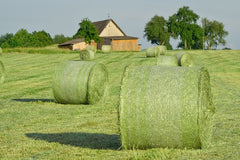
You’ve seen the ads for the hay steamers. They are beautiful and promise to reduce dust, molds, and spores. You’ve seen the article in Thehorse.com, which touts the virtues of steamed hay on reducing the allergens in feed. But you wonder, is it really worth the money? Is there any reason not to steam hay?
The biggest negative to steaming hay is a reduction in protein. A 2022 study by Pisch et al, found that the heat from steaming damaged some of the protein in the hay. Although this is not dangerous to the horse, the damage to the protein could mean a deficiency, especially to the limiting amino acids, such as lysine, methionine, and threonine.
But knowing this, how do you decide?
» Benefits to steaming hay:
-----* Reduces dust
-----* Reduces irritants
-----* By reducing the dust and irritants, you may be able to reduce the inflammatory response in the lungs.
» Drawbacks to steaming hay:
-----* Reduction in protein, which can be consequential if the protein levels are already marginal.
So, how can you make the best horse care decisions? Review these items in your decision making process:
➡ Does your horse suffer from Recurrent Airway Obstruction? (If yes, you may want to steam hay, but consider adding supplemental protein.)
➡ Is your hay dusty?
-----* Is soaking or rinsing a choice?
-----* Are cubes or pellets a choice?
➡ Is your horse kept in a barn? (Barns have more airborne particles)
-----* Can you keep your horse out of doors more often?
-----* Can you thoroughly clean your barn at least once a year?
-----* Can you sweep instead of using a leaf blower?
➡ If steaming appears to be the best option for you, can you supplement your hay with additional protein, or at the very least, with the limiting amino acids?
➡ To better aid your horse’s respiratory health, can you supplement with additional anti-inflammatories, such as spirulina, chondroitin sulfate, or MSM?
We want to keep our horse’s respiratory system as healthy as possible. To do that, we need to make informed choices as to the best course of action.